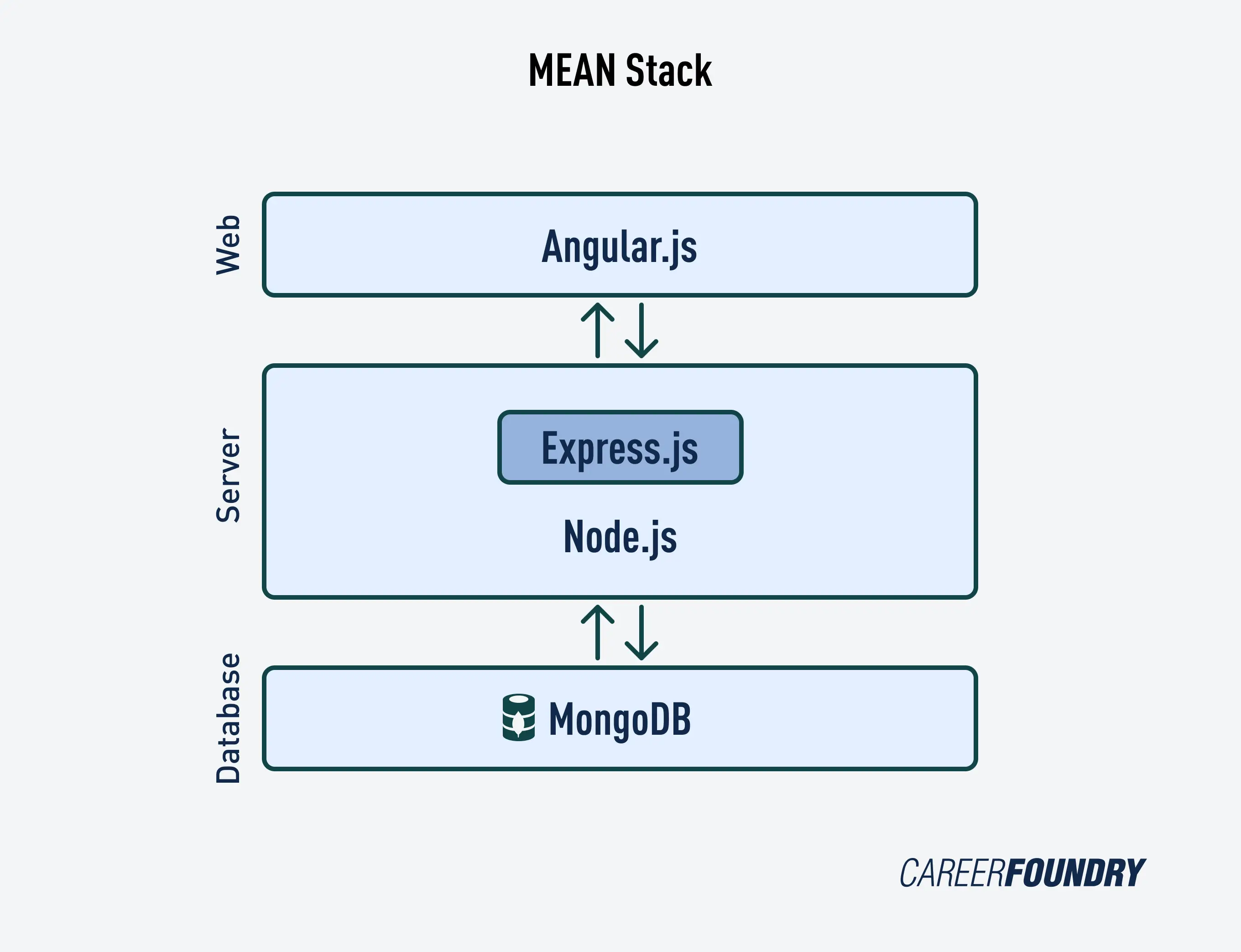The world is going digital. Apps and websites are quickly becoming an integral part of our daily lives. Today, a few clicks on an app will get food delivered to your doorstep, get you a doctor’s appointment, or even decide what you should wear for an evening occasion.
As such, developers, such as MEAN stack developers, are some of the most sought-after professionals in the current job market.
But what exactly is MEAN stack, and why should you learn it? This article is a quick guide to MEAN, why you should learn it, and how to learn it.
1. What is the MEAN stack?
The MEAN stack is a relatively new, but highly popular full-stack software bundle. It uses JavaScript technologies and is used for developing web applications.
In other words, this is a JavaScript-based tech stack, with both frontend and backend tools, used to build fast and efficient full-stack web applications.
It’s a user-friendly stack primarily used to develop dynamic and highly responsive websites. In fact, it’s one of the most popular stacks because it’s easy to use and offers the programmer a quick and organized way of creating dynamic prototypes of various web applications.
MEAN stack technologies

This tech stack uses four different technologies:
- MongoDB: A schemaless NoSQL database system
- Express JS: A JavaScript framework used to develop web applications in Node
- AngularJS: A Google JavaScript framework
- Node.js: A server-side JavaScript execution environment
Typically, MongoDB, Express JS, and Node.js are backend development frameworks, while AngularJS is used for frontend development and modification.
Therefore, the modules work together to allow data flow from the backend to the frontend or from the server to the client. Learn more about it in our MERN stack guide.
Note: It’s important not to confuse this with the similarly-named MERN stack. This tech stack shares most of the same technologies, but uses the JavaScript library React instead of Angular.
What is the MEAN stack used for?
MEAN stack is a collection of software packages and other development tools that make web development faster and easier. Web developers use it to produce web applications that are dynamic and more sustainable.
For example, The Weather Channel, one of the largest weather broadcasting channels, relies heavily on MEAN features for its website as well as its software to function properly. It also uses AngularJS for its weather reports—for functionality and simple weather predictions. Additionally, it helps it create multiple themes for different regions and weather conditions depending on worldwide predictions.
Another good example is project management tool Trello, which is based on Node.js. Trello developers used MEAN to create a system with transparent, fast, and event-driven predictions.
Although the stack isn’t necessarily ideal for every situation, it is very effective for various cases. For instance, it’s super flexible and has a great capacity to manage multiple connections simultaneously. This makes it a great choice for building MEAN stack applications.
Other practical examples of how to use the MEAN stack include:
- Expense tracking
- Calendars management
- Tools for managing workflows.
- Searching for locations and mapping
- Tools for managing workflows.
2. Why learn the MEAN stack?
The tech industry is growing fast. For example, experts estimate the Machine Learning industry to grow from $21.17 billion in 2022 to about $209.91 billion by 2029. This means that it’s never too early to get your foot into this and other exciting industries.
What’s more, the MEAN stack is an effortless and rewarding way to get started. It allows developers to write a single code in one language for both frontend and backend making it very easy to learn and implement.
Here are some more pros and cons of learning this technology.
Advantages
- Open source: All the technologies are open-source and available for free.
- Universal coding is possible: MEAN stack is one of the stacks that allow you to transfer code from one framework to another easily.
- Simple and intuitive: The stack also allows programmers to write code in a single language in all frameworks, both on the backend and the frontend.
- Fast and effective: Since the code is written in a single language, it’s easily transferable, making the development fast and effective. Plus, Express makes it simple to route and manage HTML pages and answers.
- Flexible, scalable, and extensible: MEAN stack applications are easy to customize and configure, which offers the flexibility needed for most web applications.
- Cost-effective: Because the MEAN stack uses a single language, you don’t need a large team of experts to develop and test your applications. Plus, it’s time-saving since most of the code can be transferred from one framework to another.
Disadvantages
- Specific general JS coding guidelines: Although there is no shortage of MEAN stack manuals and courses, there are no proper guidelines or JS code standards for this technology.
- Poor server isolation from business logic: Since the area project management is super fast, both server and client functionalities may lead to insufficient segregation. This might result in improper software practices.
3. MEAN Stack FAQs
Now that we’re familiar with this tech stack and why it’s worth your time, let’s briefly answer some frequently asked questions around it.
Which language is used in the MEAN stack?
All frameworks of the MEAN stack are based on JavaScript. The language is used across all four layers of the stack, namely MongoDB, Express, Angular, and Node.
It utilizes JavaScript on both the backends/servers and the frontends/clients, which ensures that the web application is fast, reliable, and secure.
Is MEAN stack difficult to learn?
Typically, no. The MEAN stack is an open-source web application development system that’s based on JavaScript, making it highly intuitive and easy to adapt and maintain.
As a result of this, it’s fairly easy to learn and implement as well. In fact, you can work with the MEAN stack without much training if you’re already a full-stack web developer.
Note: If you’re starting out as a coder, don’t get distracted by all of the tools and technologies, and learn vanilla (or basic) JavaScript first. The benefits of knowing the nuts and bolts of the language will give you a solid foundation that will stand to you later on.
Why is MEAN stack so popular?
The MEAN stack is highly flexible, scalable, and extensible, making it the perfect solution for developing cloud-native applications.
Additionally, it’s open source, effective, and easily manageable, making it one of the most cost-effective tech stacks available today. As a result, the it’s widely recognized and extensively used by many developers and small business owners worldwide.
What’s a MEAN stack developer’s salary?
In the United States, the annual salary for a MEAN stack developer ranges between $75k to $120k. According to Glassdoor, the average salary is $80,430 per year. This is based on the number of salaries data collected from the sample size.
Additional pay, which includes bonuses, tips, and commissions, amounts to an average of $12,688 per year on top of that.
Is MEAN stack in demand?
Yes. MEAN stack developers are popular and highly sought after.
Suppose you have a strong foundation in JavaScript and other high-level programming languages and apps. In that case, you’ll be a valuable and competent MEAN stack programmer who’s always in demand.
4. How to Learn the MEAN Stack
Previously, you needed to join a coding school to gain a speciality and attain expertise and training in full-stack development before you could become a MEAN stack developer.
But not anymore. Today, the pattern has shifted, thanks to technological advancement and modern best practices.
It’s now easy to learn the MEAN stack. You just need to gain proficiency in the following:
- Cascading Style Sheets (CSS)
- HTML
- Any web server, such as Nginx or Apache
- Scripting in Java
- Languages such as Ruby, PHP, or Python.
- Implementation OS: FreeBSD, Linux, or CentOS
- Database management systems, such as Oracle or MySQL.
- Any version control system, such as Git
Final thoughts
As we’ve seen, the MEAN stack is highly popular, and that doesn’t seem to be slowing down soon.
In fact, we can say that it’s an essential technology of the future. As such, being a MEAN stack developer can be a highly rewarding job now and in the future.
Quite a lot of the better web development and software engineer courses, such as the CareerFoundry Full-Stack Developer Program, teach their students the MEAN stack as a key part of their curriculum.
If you’d like to learn more about the world of coding, check out these articles:
